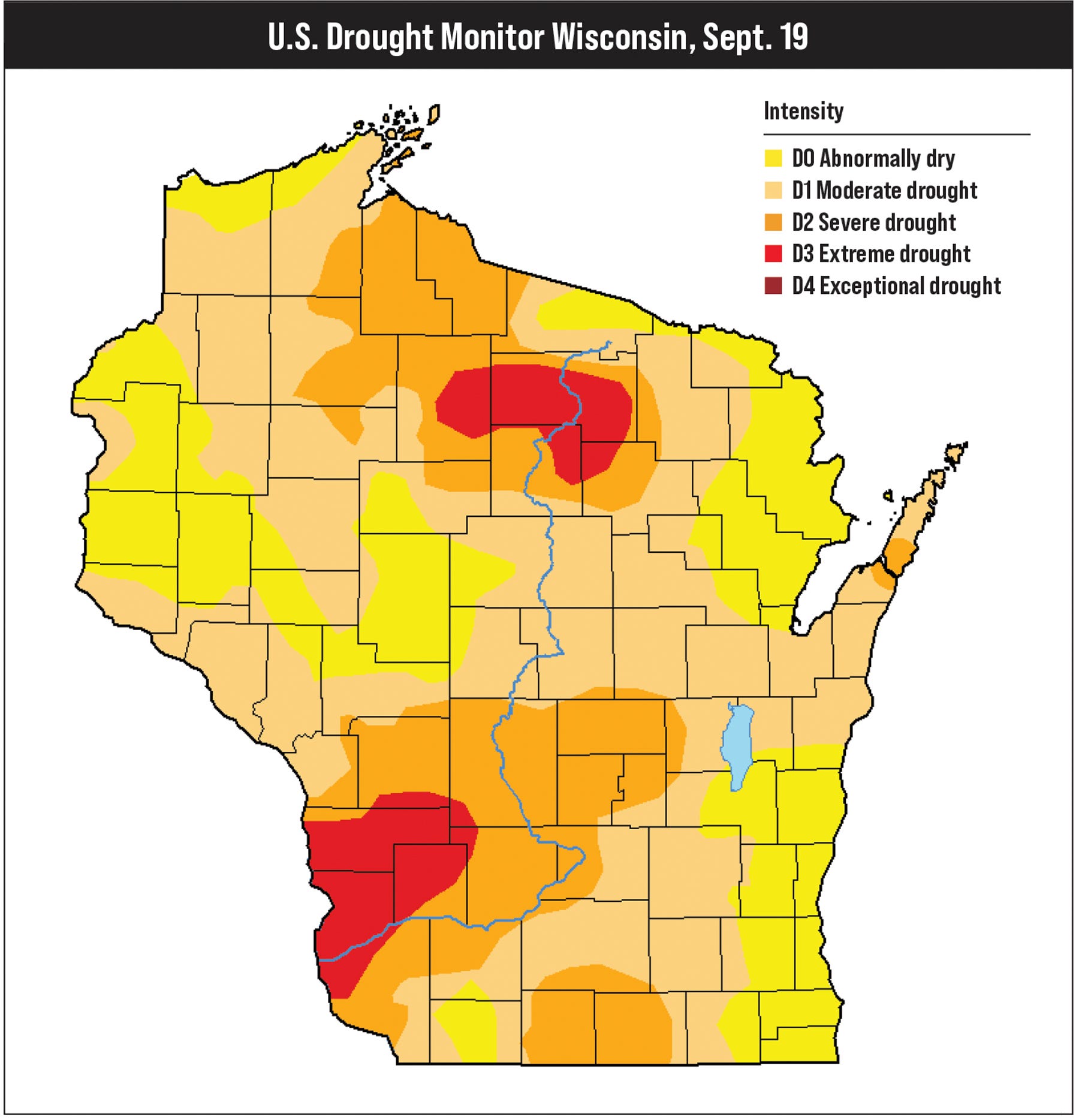October 17, 2023

by Steve Okonek
Wisconsin and much of the Midwest experienced drought during most of the growing season of 2023. Crop response and yields have been affected by soil type and the timing of rain events. The impact of cover crops on crop response to drought has been variable as well. Where do cover crops fit in the crop management scheme, and what is the impact of cover crops on drought conditions and crop management under climate extremes?
To better understand and answer that question, we must step back and understand what makes a soil resilient not only to drought, but also to other climate extremes, including heavy rain and prolonged wet periods. Soils are composed of sand, silt, clay and organic matter in varying amounts, depending on the type of soil and where that soil formed in the landscape.
Soil organic matter and clay are the soil constituents that hold water and nutrients in soils. Not all clay minerals are equal in their ability to hold water and nutrients. There is little we can do to alter the clay minerals themselves or increase the amount of clay we have in our soils.
Soil aggregates are formed through a complex process of flocculation, which can vary depending on the soil type and environmental conditions. Flocculation is the binding together of many small particles into larger clumps and eventually aggregates. The process is driven by organic matter, soil microbes, roots, clay, calcium and magnesium, and wetting and drying cycles.
The presence of organic matter, such as decaying plant material, can act as a binding agent to help hold soil particles together. Soil microorganisms like fungi and bacteria produce a glue-like substance that helps the soil particles stick together. Roots can physically push soil particles together and release exudates that act as binding agents. Certain types of clays can swell and promote aggregation when they absorb water. The wetting and drying cycles help hold particles together as the soil dries. Calcium and magnesium can also influence to bind soil particles with their positive charges.
Soil aggregates are clumps of soil that make it crumbly and easy to plant into. Aggregates also help water to infiltrate and help the soil hold water in the pores that form between and in the aggregates. Soil with poor aggregation will have ponding issues, will be difficult to till, will bake dry like concrete, or will be smeary like pudding when wet.

Soil organic matter is the only soil constituent you can increase, but that is not easily accomplished. So, how do you increase soil organic matter, and what do cover crops have to do with it?
Increase soil organic matter
The first step in increasing soil organic matter is to reduce soil erosion. Soil erosion removes soil from a field and relocates it elsewhere in the field or off the field. Erosion not only thins the topsoil, but also alters the percent of sand, silt, clay and organic matter, altering how the soil performs under climate extremes. Soils with depleted organic matter levels will allow water to run off, and water that does infiltrate into the soil will not be held for later use by the crop.
Cover crops and crop residue remaining on the soil surface due to reduced tillage or no-till farming are the best ways to reduce soil erosion and the loss of soil organic matter. Cover crops help build soil organic matter by increasing surface residues and by having living roots in the soil for more of the year than typical annual crops of corn and soybean provide. Living roots not only hold soil physically, protecting soils from erosion, but they also feed the soil, as plants exude various compounds into the soil to feed bacteria so the bacteria can help bring nutrients to the plant roots. The root exudates increase biological activity near the roots and increase the aggregation of soil particles. Remember, you want soil aggregates because they help water infiltrate and help hold water for later use.
Cover crops can be impactful following low-residue crops such as corn silage and soybeans. Soybean residue breaks down easily because of its low carbon-to-nitrogen ratio. Corn silage is harvested early in the fall, exposing soil to erosion longer in the fall and immediately in the spring. Adding a winter cereal crop of rye, triticale or wheat following corn silage or soybeans is an easy place to start cover cropping, and adding cover crops after both crops can be impactful in terms of soil and water quality.
Competition for water
One concern farmers have is that cover crops may take up too much soil moisture in the spring, depleting it for the main crop that will follow. Keep in mind that most planting seasons in Wisconsin have adequate or surplus soil moisture. A cover crop can help in a wet spring by using excess soil moisture, allowing you to plant earlier in drier soil. Terminate the cover crop early in a dry spring. Reduce or eliminate tillage to maintain surface residue to reduce erosion.
Building resilient soils is a long game. You have to play all four quarters and be ready for overtime if you are going to win and protect your soils from climate extremes. Cover crops and building soil organic matter are two of the tools you can use to build resilient soils.
Okonek is the University of Wisconsin Extension agriculture agent for Jackson and Trempealeau counties.
You May Also Like




